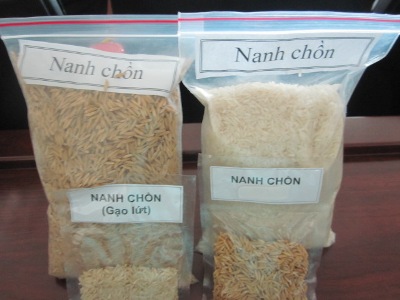
On May 27, Department of Science and Technology of Ba Ria
Vung Tau province held a council to evaluate the study
“Selecting and building rice growing technical process for Nanh Chon,
speciality of Ba Ria - Vung Tau province”. The head of the project is
MSc. Dao Minh So (Institute of Agricultural Science of Southern Vietnam).
The subject’s objective is to find out 1 to 2 lines of
Nanh Chon rice, an excellent rice specialty of Ba Ria Vung Tau province. The
chosen rice lines have to satisfy some conditions such as having high yield,
good quality, distinct aroma and high adaptation to Ba Ria - Vung Tau
environment. In addition, the study also aims to identify
key factors affecting rice productivity, quality and the structure of rice
cultivation system of the province. Finally the study evaluates
feasibility of growing Nanh Chon rice in Ba Ria
- Vung Tau by the advantage comparison with other conventional rice varieties
of the province.
The subject consists of different parts:
surveying current state of rice cultivation of Dat Do district; testing adaptation
of potential Nanh Chon rice; studying technical
methods to grow Nanh Chon rice; identifying effects of reservation conditions
on rice quality.
Some important results of the subject are
listed as below: Update the information of rice production, applying
technical advances in rice and the natural and social conditions of original
places of NC rice (Dat Do district) to facilitate the recovery seed production;
Lines of Nanh Chon rice have similar growing characteristics
which belong to “mua lo” variety. Nanh Chon rice has good resistance to rice
blast and leaf scald disease but susceptible to brown backed plant hopper
disease. Average yield of prospective lines ranged from 3.5 to 3.8 ton/ha, and
reached 4.0-4.5 ton/ha in some areas. Nanh Chon rice has many special qualities
such as having long and thin shape, small size, high milling rate (>55%) and
low average amylose content (21-22%). Some better lines of Nanh Chon rice have
grain length of about 55-60mm, become soft and spongy when cooked. They also
have stable fragrance at level 3 with aromatic substances (2AP) range from 2,60
to 2,906 µg/kg. In total 7 Nanh Chon rice lines being experimented, NC2 has the
best performance in yield and quality, wide adaptation, high quality and aromatic
fragrance always remain at high level than other seed.
Two methods of seeding were experimented
on Nanh Chon rice to find out the best seeding time for each. For the
conventional seeding method, middle to the end of August is the best period for
seeding, resulting in high yield and quality and having desired harvest period
as about 3-4 weeks before the traditional New Year. For the wet direct seeding
method, the best time for direct seeding is August with the amount of seeds for
each ha is about 40 kg.
To preserve quality of Nanh Chon rice, the preservation
period is recommended to keep below 7 months in normal conditions and below 9
months in controlled environment with temperature about 20 degree Celsius. With
the temperature about 10 degree Celsius, the preservation time can be longer
than 9 months.
The study built 1.74 ha of Nanh Chon rice with 9 farmers
joined at three production areas: Phuoc Hoi, Lang Dai, Long Tan town, yielding
3.13ton/ha to 3.95 ton/ha, averaging 3.5 ton/ha. If growing in fall-winter
term, Nanh Chon rice model has profit increased 1.82 times and cost reduced by
28% with material cost reduced by 44%, comparing to growing short term rice.
Growing Nanh Chon rice in summer-fall term lead to increase 1.44 times in
profit and reduced cost by 15% and material cost by 22% comparing to the option
to grow the conventional short term rice twice a year (summer-fall term and
fall-winter term).
The council highly evaluated results of
study as having highly practical values and original objectives being met. The subject
is accepted and classified as good by the council.

 Previous page
Previous page Back to top
Back to top







